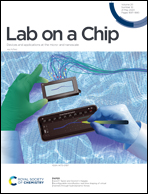In-air EIS sensor for in situ and real-time monitoring of in vitro epithelial cells under air-exposure
Abstract
This paper reports in-air monitoring of in vitro monolayer cells under air-exposure utilizing electrochemical impedance spectroscopy (EIS). In-air impedance measurement was performed by placing integrated electrodes laterally, instead of vertically, to a cell membrane, avoiding electrical disconnection, unlike conventional transepithelial-electrical-resistance (TEER). The in-air EIS sensor platform mainly consisted of two chambers, separated by a porous membrane where cells were cultured, that enabled cell exposure to both air (apical side) and liquid (basal side) for long-term measurement. On top of the membrane, EIS interdigitated electrodes were patterned and lung epithelial cells (A549 type II) were cultured with air exposure on one side. The fabricated in-air EIS sensor successfully demonstrated in situ real-time measurement of cell populations in confluency in the range of 7.8 × 104 and 9.6 × 105 cells per cm2 at a sensitivity of 3.0 × 10−2 Ω per cell in impedance and in the range of 1.0 × 104 and 9.6 × 105 cells per cm2 at a sensitivity of 0.17 × 10−15 F per cell in capacitance under AC frequencies of 100 kHz and 1 MHz, respectively. It also successfully monitored transient modulation of tight-junctions that collectively began to open in 30 minutes after the injection of 100 ng ml−1 TNF-α (a relaxation agent), reached maximum relaxation with a 12.6% increase in impedance value and a 12% decrease in capacitance in 60 minutes, and recovered back to its original junction status after 720 minutes, which confirmed the observation in animal models in the literature. Note that the opposite trends in impedance and capacitance allowed the in-air EIS sensor to distinguish cell population changes from tight junction modulation. It was concluded that the developed in-air EIS sensor in an in vitro platform can enable in situ and real-time monitoring of the population of the ‘air-exposed’ cells as well as the modulation of tight-junctions, which has not been demonstrated yet.



 Please wait while we load your content...
Please wait while we load your content...